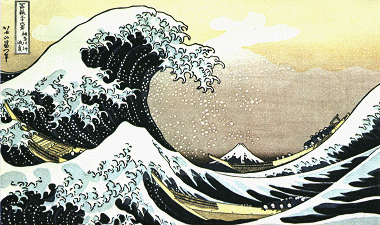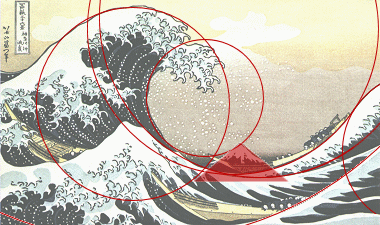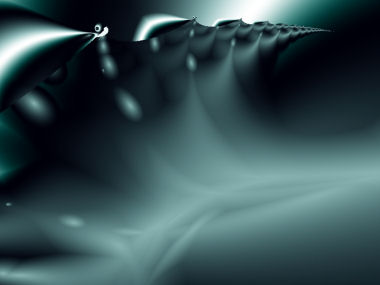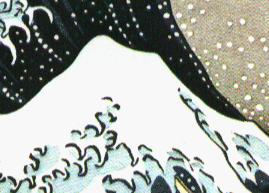Math in art - Hokusai’s “The Wave”
By Murray Bourne, 24 Mar 2007
Katsushika Hokusai painted The Wave in 1831 when he was in his early 70s. He found himself impoverished after his grandson gambled away his fortune. Hokusai started painting again after he had already retired and given away his name.
The title of his most famous painting is variously translated In the Hollow of a Wave off the Coast at Kanagawa and The Great Wave off Kanagawa. It was the first of a 36-part series of views of Fuji-san.

I have always liked the way that my eye is drawn to Fuji only after I have experienced the rest of the drama of the painting.
I used to live in Kanagawa Ken, so the painting has particular resonance for me.

Hokusai used various mathematical elements in the image, including basing the waves on circles and of course, Fuji is a triangle.

The threatening "fingers" of the wave are fractal-like. The following fractal image is reminiscent of Hokusai's work:

Image source.
[See more on fractals.]
And let's not forget the oarsmen in the boats. Sometime soon, they will surely be smashed to pieces by the wave. By deduction, we can work out that they were in a hurry (more oarsmen than normal) and that they were heading out to sea (an odd thing to do in such conditions).
Wave scientists do not believe we are looking at a tsunami. It is a pyramidal wave, which is apparently quite possible in the mouth of the Kanagawa.
There is a school of thought that believes there is a second image of Fuji in the painting. The other one is actually a visual joke, appearing as one of the smaller waves below the large wave:

Maybe, but I'm not that convinced.
Probably the most remarkable thing about the painting is that it captures a photograph-like moment in time, long before cameras ever appeared in Japan.
See the 11 Comments below.
25 Mar 2007 at 4:16 am [Comment permalink]
Apparently, Japanese people will "read" the painting differently. They would look at it from right to left, and with the strong cultural association, focus on Fuji-san as the main feature.
The effect of the painting would be of a waving crashing onto the face of the viewer. I guess you could flip the image so that we left-to-rightists can see what Hokusai intended.
25 Mar 2007 at 9:04 am [Comment permalink]
Thanks, Vinod. I meant to mention the right-to-left aspect, but forgot.
Actually, an observer's eye usually goes to the largest and brightest object in any image. For me, it's the crest of the wave.
17 May 2010 at 10:20 pm [Comment permalink]
Really fascinating piece. A favourite of mine because I lived in Japan for a few years too. (Kyoto city.) I will use this with my IB Theory of Knowledge class.
Many thanks. Great site allround. I also used the Beauty in maths page.Wonderful too.
21 Jan 2012 at 10:10 am [Comment permalink]
I much prefer inrofmaitve articles like this to that high brow literature.
11 May 2013 at 4:03 pm [Comment permalink]
the smaller wave is an intermediate iteration of the fractal, not an arbitrary placement of a second fuji. I interpret each element of the piece to be an iteration:
The mountain resembles the clouds > the wave resembles the mountain > the small fingers resemble the wave
12 May 2013 at 9:34 am [Comment permalink]
@George: Thanks for the extra insight. Iterations make a lot of sense in this painting!
19 Dec 2015 at 4:33 am [Comment permalink]
[…] Math in art - Hokusai’s “The Wave” […]
24 Aug 2016 at 2:01 pm [Comment permalink]
Another mathematical angle is the basic design/lay out is built up after the “Golden Cut”.
The "Golden Cut" gives visual directions to the eye movement.
The "Golden Cut" is commonly used in Western art, especially during the renaissance period.
Not only is the circular pattern repeated through out the design but also the triangle/triangular motif of Fuji.
The circles adds movement and the triangles adds stability and power.
The "wave" is no a tsunami but a type of "freak" wave which forms of a combination of several waves from different directions. It is a very rare phenomena, the resulting wave can be of gigantic proportions in what is otherwise a fairly untroubled sea. One of the few place were you can find these rare waves, with some regularity, is the Pacific outside Tokyo Bay. Needles to say these waves is a serious treat to any ships, even large merchant ships today.
18 Feb 2017 at 9:03 pm [Comment permalink]
[…] Imagen extraída del blog Intmath. […]
11 May 2017 at 11:56 am [Comment permalink]
Its great to see math being used for Art.
I used an Recurrent Neural Network for Style transfer on "All Star" by Smash Mouth, and made it look like a Kanagawa wave painting.
Check it out, it might be the future of entertainment
https://youtu.be/08p0j_Y4lK0
3 Mar 2020 at 12:04 pm [Comment permalink]
The second "fuji" in the small wave is plausible. The view of Fuji from the southern shizuoka looks exactly like it.